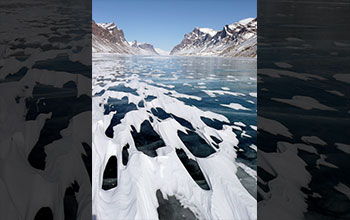Multimedia Gallery
Studying Glacier Activity on Baffin Island (Image 3)
Ayr Lake, Baffin Island, Canada. A research team from the University at Buffalo found that the island's glaciers reacted rapidly to past climate change, providing a rare glimpse into glacier sensitivity to climate events.
More about this image
The University at Buffalo (UB) team, which was headed by Jason Briner, an associate professor at UB, studied and dated moraines -- piles of rocks and debris that glaciers leave behind when they expand -- and other geological features. Their findings showed that mountain glaciers on Baffin Island, along with a massive North American ice sheet, expanded quickly when the Earth cooled about 8,200 years ago. This finding adds to the evidence that ice sheets reacted rapidly in the past to cooling or warming and raises concerns that they could do so again as the Earth heats up. The finding was particularly surprising because the cold spell was very short -- the temperature fell for only a few decades and then returned to previous levels within 150 years or so.
"One of the questions scientists have been asking is how long it takes for these huge chunks of ice to respond to a global climate phenomenon," says Briner. "People don't know whether glaciers can respond quickly enough to matter to our grandchildren, and we're trying to answer this from a geological perspective, by looking at Earth's history." He adds that "what we're seeing is that these ice sheets are surprisingly sensitive to even short periods of temperature change."
This research was supported by National Science Foundation grants ARC 09-09334, BCS 10-02597 and BCS 07-52848. (Date of Image: May 2009) [Image 3 of 3 related images. Back to Image 1.]
Credit: Jason Briner
Images and other media in the National Science Foundation Multimedia Gallery are available for use in print and electronic material by NSF employees, members of the media, university staff, teachers and the general public. All media in the gallery are intended for personal, educational and nonprofit/non-commercial use only.
Images credited to the National Science Foundation, a federal agency, are in the public domain. The images were created by employees of the United States Government as part of their official duties or prepared by contractors as "works for hire" for NSF. You may freely use NSF-credited images and, at your discretion, credit NSF with a "Courtesy: National Science Foundation" notation.
Additional information about general usage can be found in Conditions.
Also Available:
Download the high-resolution JPG version of the image. (4.3 MB)
Use your mouse to right-click (Mac users may need to Ctrl-click) the link above and choose the option that will save the file or target to your computer.

